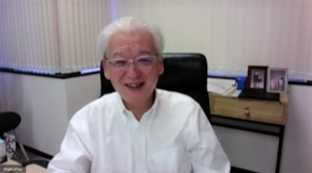Convention Case Studies
Japanese Orthopaedic Association Annual Meeting
Due to the influence of the new coronavirus, the Japanese Orthopaedic Association switched their 93rd Annual Meeting to a fully online academic meeting from June 11th to August 31st this year. We interviewed Dr. Keishi Marumo, chairman of this general meeting, about his ideas for running an online conference and the difficulties he faced.

Conference Overview
| Event Name | The 93rd Annual Meeting of the Japanese Orthopaedic Association |
|---|---|
| Dates | May 11- August 31, 2020 |
| Location | Online |
| Attendance | 15,825 |
Please tell us about the content and scale of the 93rd Annual Meeting of the Japanese Orthopaedic Association.
Currently, the Japanese Orthopaedic Association has about 26,000 members and depending on the size of the venue, 8,000 to 11,000 people participate in the four-day academic meeting every year.
How did you switch the conference to online?
We had an online academic meeting after the Great East Japan Earthquake in 2011, so this was our second virtual meeting. The situation was a little different from the time after the earthquake. At the end of January this year, the future was quite uncertain due to the new coronavirus, so we started preparations with a view to hold it online. At the Japanese Orthopaedic Association's academic meeting steering committee gathering in mid-February, a presentation was given on the proposed scale and form of the potentially online event, and the final decision was made by the steering committee in March.
As the organizer, what points did you pay attention to when preparing for the online conference?
The possibilities of the internet environment have changed tremendously since we held the first online meeting following the 2011 earthquake. Due to this, our 2020 online conference was prepared as a fresh, new attempt. It’s not fun to just simply go online, so I wanted to work positively towards incorporating content that can only be done online as much as possible. It was a pity that we couldn’t hold the general meeting at the venue as planned as we had been preparing for it for the past three years. However, since the virtual academic meeting is a new initiative, there were high levels of anticipation. We were thinking we’d like to try lots of new things, so we planned virtual exhibitions, presentations on the needs of medical-engineering collaboration, e-sports competitions, and online social gatherings.
For the regular event, I had been collaborating with NHK Enterprises to use the latest film technology to try to create and screen a short 3D film on the topic of “What is orthopaedic surgery?” Since the meeting was switched to online, we made it possible to watch the video on YouTube.
The PCO (Professional Congress Organizer) managed the event also produced an animation showing the event “opening” in Fukuoka to be shown on the event website. It was extremely fulfilling to work with everyone at the PCO to successfully execute such a fun project.
Did you face any troubles unique to online meetings?
Above all, the online infrastructure is of vital importance. It was difficult to predict in advance how many people will concentrate access and at what times. Due to this, we did experience a system crash, and the video of the opening ceremony was delayed going online for a week.
We felt the infrastructure built this time had plenty of scope for fluctuations in traffic. However, it was a feature of this general meeting that in order to credit participants with points for education and training, it was necessary to link with the membership information in the conventional Japanese Orthopaedic Association member database. To be more specific, it was necessary to link the attendance status of education and training and the results of examinations with the information of each member. However, as the Japanese Orthopaedic Association database and this new online academic meeting system were not fully integrated, there was a traffic jam when we went to get the member information from the Japanese Orthopaedic Association database, and as a result, the network speed slowed down to a crawl. Fine-tuning was done to enable the two systems to connect smoothly.
The online meeting was held over a relatively long period from June 11th to August 31st. How many participants registered?
According to the final report, a total of 15,825 people participated, including non-members, speakers, and invitees, etc.
When you switched to the online format, did you expect the same number of participants as at a conventional general meeting?
No, not at all. At the time of the 2011 online general meeting, there were only 4,300 participants, so we first set the participation fee based on the number of participants in 2011.
On the other hand, this time, via the new system, up to 28 credits could be earned for education and training, so I thought the number of participants might be higher than last time.
The Japanese Orthopaedic Association usually holds around 4,000 education and training lectures throughout Japan each year. However, due to the new coronavirus for two to three months, no lecture was held at all, which made me think there could also be many specialists who needed education and training credits to renew their qualifications.
That said, it’s very difficult to predict. I’ve heard from various sources that the number of participants budgeted for is often exceeded when a meeting goes online.
In the case of our event too, there were more participants than originally forecast, and the revenue swelled as a result. The conference fee was 18,000 yen. Considering actual participant numbers, we could perhaps have made it cheaper, however, due to the cancellation of the regular event, we had a considerable amount of expenses to cover, such as cancellation fees for the venue and accommodation and flights for invitees from overseas, and so on. Having calculated all the costs we were likely to incur, the board of directors finally decided on the participation fee mentioned above.
Was the cancellation fee for the venue originally scheduled to be exempted?
The conference facility we had been planning to use was a public facility. As a state of emergency was declared by the Government of Japan, we were exempted from venue cancellation fees.
In contrast, hotels could offer some discounts but still charged cancellation fees. Other expenses included examples such as a speaker who was planning to come from overseas and purchased a flight ticket at a discounted rate, making the cancellation fee rather high.
In the beginning, we estimated we were facing a considerable amount of cancellation fees, but in the end, it was less than expected, fortunately.
Did the guest lectures from overseas proceed as planned?
We had planned 35 sessions and 41 presentations in total by speakers invited from overseas.
However, in the online format, this was reduced to 25 sessions and 27 presentations. We had also planned to have 8 presentations as a program in association with the American Academy of Orthopaedic Association (AAOS), but this has reduced to 7 presentations.
Why did the number of lectures decrease? Did some speakers drop out citing online lectures being more difficult to deliver? Or did time differences cause problems?
Luncheon seminars could not be delivered on demand because of issues to do with corporate compliance. Due to this, we held all lunch and evening seminars live, but it was difficult for people overseas to participate in live events due to the time difference.
There were about 10 fewer guest lectures by people invited from overseas than originally planned. But as a whole, 90% of the planned lectures were held online when taking into account commemorative lectures, special lectures, general lectures, and poster sessions, etc.
Did the speakers themselves handle the shooting of the videos for their lectures?
The luncheon seminar was a live stream so we, the organizers handled it. For commemorative and special lectures we prepared a location and recorded them there. We had intended for the general educational lectures to be recorded by the speakers themselves. However, as not all of them are accustomed to making videos, we received many inquiries; at their peak, we received almost 250 inquiries in a day. We also experienced problems with the system crashing, so the first month of the online conference really was tough.
Was there a change in attitude from the sponsors when it switched to a virtual event?
Pharmaceutical manufacturers are accustomed to distributing information online. Originally, we had 55 pharmaceutical groups apply to participate in luncheon and afternoon seminars. In the end, 54 groups took part in co-sponsored seminars online. There were 2-3 companies that couldn’t accommodate the online format. On the contrary, because it was held online, one or two new companies joined us.
Conversely, the exhibition side of things was more problematic. We had had 99 companies sign-up to take part in the regular general meeting. When it switched to the virtual exhibition format, 40 companies (including companies that only advertised) participated in the online event, of which 29 produced virtual exhibitions. With a total of 40 companies participating, our income decreased to about 60% of what it would originally have been.
What sort of feedback did you receive from sponsors regarding the virtual exhibition?
There were quite a lot of companies that refused to exhibit unless the exhibition would be interactive. Yet when I spoke to someone from a large company they commented, “I would think small and medium-sized companies can promote themselves by actively using online. It was surprising that such companies pulled out of the exhibition.”
In the future, I think that the format of the conference will change and develop options for different types of participation, through methods such as the so-called hybrid format, where the event is held partially online. This time, we may not have been able to appeal strongly to SMEs, but I feel if SMEs can express themselves a little more, they will also be able to participate in virtual exhibitions more.
I heard that for one large global company that participated, it was their first time to take part in a virtual exhibition, so it was reported on in the company's internal newsletter. In that sense, it can be said that this virtual exhibition broke new ground.
I heard you managed to hold an interuniversity e-sport tournament. They are sometimes a part of academic association meetings, but how do you realize that online?
Since the Orthopaedic Association is inseparable from the sports industry, we have been holding baseball tournaments in conjunction with the general meeting ever since the meetings began. We started playing football 15 years ago and basketball three to four years ago. As sports were already a regular part of our meetings, and e-sports are becoming more widely recognized, we figured it could be fun and there is no chance of injuries, so why not give it a go?
What do you think will be the future format of the conference?
I don’t think this is the end of the online event. There are benefits to online in terms of reducing the time and cost involved in participating, and information and communication technologies will continue to become more advanced.
Nevertheless, I think meeting in real life is still meaningful. Especially for young participants, there are many things that can only be done face-to-face, such as meeting in person and talking with prominent overseas teachers about studying abroad and being able to promote oneself.
Lastly, regarding the field of Orthopaedic, since there are so many academic societies and research groups, I think it is necessary to organize and integrate them and clearly show the significance of each academic society. I think this coronavirus storm has provided a good opportunity to do this. In 2026, the Japanese Orthopaedic Association will celebrate its 100th anniversary, but in terms of sponsorship, it will be difficult to continue as before with many academic societies and research groups. Under the leadership of the Japanese Orthopaedic Association, for the benefit of all members, I think that related academic societies and study groups should be significantly reviewed and re-organized.

